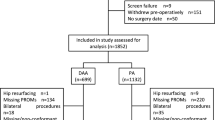Abstract
Background
The aim of this study was to evaluate the possible complications specific to the continuous intraarticular anaesthesia (CIA) in a minimally invasive posterior approach in total hip arthroplasty and its possible effects on the recovery, especially on pain and the length of hospitalisation.
Materials and methods
The surgical procedure is first precisely described step by step with numerous per-operating photographs. Particular technical points are detailed. The errors to be avoided are specified. A prospective series of 70 first-line total hip arthroplasties (one half with and one half without CIA) are analysed for the well-known results of total hip arthroplasty but specifically assessing: (a) specific possible complications to the minimally invasive posterior technique with the prolonged local anaesthesia and (b) effects on pain, duration of hospitalisation and satisfaction in patients (questionnaire).
Results
(a) Very low level of immediate post-operative pain was observed in almost all of the patients. (b) Patient satisfaction was high in our series. (c) A repeated education was provided multiple times to avoid specific complications following the absence of pain and consequent inattention.
Discussion and conclusion
The minimally invasive posterior approach with continuous intraarticular anaesthesia is an entirely reliable hip arthroplasty procedure. The patients exhibited a significantly less pain and a fast rate of recovery, but preparatory education must be even more significant.
















Similar content being viewed by others
References
Wright JM, Crockett HC, Delgado S, Lyman S, Madsen M, Sculco TP (2004) Mini-incision for total hip arthroplasty: a prospective, controlled investigation with 5-year follow-up evaluation. J Arthroplasty 19:538–545
Wenz JF, Gurkan I, Jibodh SR (2002) Mini-incision total hip arthroplasty: a comparative assessment of perioperative outcomes. Orthopedics 25:1031–1043
Goldstein WM, Branson JJ, Berland KA, Gordon AC (2003) Minimal-incision total hip arthroplasty. J Bone Joint Surg (Am) 85:33–38
Berger R (2003) Total hip arthroplasty using the minimally invasive two-incision approach. Clin Orthop 417:232–241
Hartzband M (2004) Posterolateral minimal incision for total hip replacement: technique and early results. Orthop Clin North Am 35:119–129
Digioia AM, Plakseychuk AY, Levison TJ, Jaramaz B (2003) Mini-incision technique for total hip arthroplasty with navigation. J Arthroplasty 18:123–128
Woolson ST, Mow CS, Syquia JF, Lannin JV, Schurman DJ (2004) Comparison of primary total hip replacements performed with a standard incision or a mini-incision. J Bone Joint Surg (Am) 86:1353–1358
Howell JR, Masri BA, Duncan CP (2004) Minimally invasive versus standard incision anterolateral hip replacement: a comparative study. Orthop Clin North Am 35:153–162
Chiron P, Laffosse J, Fabié F, Puget J (2005) Prothèse totale de hanche. In: Puget J (ed) Les choix. Elsevier, Paris, pp 269–283
Chung WK, Liu D, Foo LS (2004) Mini-incision total hip replacement - Surgical technique and early results. J Orthop Surg (Hong Kong) 12:19–24
Sculco TP (2004) Minimally invasive total hip arthroplasty in the affirmative. J Arthroplasty 19(4: suppl 1):78–80
Nakamura S, Matsuda K, Arai N, Wakimoto N, Matsushita T (2004) Mini-incision posterior approach for total hip arthroplasty. Int Orthop 28:214–217
Chimento G, Pavone V, Sharrock N, Kahn B, Cahill J, Sculco TP (2005) Minimally invasive total hip arthroplasty. A prospective randomized study. J Arthroplasty 20:139–144
Ogonda L, Wilson R, Archbold P, Lawlor M, Humphreys P, O’brien S et al (2005) A minimal-incision technique in total hip arthroplasty does not improve early postoperative outcomes. J Bone Joint Surg (Am) 87:701–710
Chiron P, Laffosse JM, Tricoire JL, Giordano G, Puget J (2006) Etude prospective et comparative entre la voie d’abord postérieure minimale invasive et la voie postérieure standard dans les prothèses totales de hanche. e-mémoires de l’Académie Nationale de. Chirurgie 5(3):06–16
Goldstein WM, Branson JJ (2004) Posterior-lateral approach to minimal incision total hip arthroplasty. Orthop Clin North Am 35:131–136
Klein GR, Posner JM, Levine HB, Harzband MA (2017) Same day total hip arthroplasty performed at an ambulatory surgical center: 90-day complication rate on 549 patients. J Arthroplasty 32(4):1103–1106
Rasmussen S, Kramhøft MU, Sperling KP, Pedersen JHL (2004) Increased flexion and reduced hospital stay with continuous intraarticular morphine and ropivacaine after primary total knee replacement: open intervention study of efficacy and safety in 154 patients. Acta Orthop Scand 75(5):606–609
Andersen KV, Pfeiffer-Jensen M, Haraldsted V, Søballe K (2007) Reduced hospital stay and narcotic consumption, and improved mobilization with local and intra-articular infiltration after hip arthroplasty: a randomized clinical trial of an intra-articular technique versus epidural infusion in 80 patients. Acta Orthop 78(2):180–186
Andersen LJ, Poulsen T, Krogh B, Nielsen T (2007) Postoperative analgesia in total hip arthroplasty: a randomized double-blinded, placebo-controlled study on peroperative and postoperative ropivacaine, ketorolac, and adrenaline wound infiltration. Acta Orthop 78(2):187–192
Kerr DR, Kohan L (2008) Local infiltration analgesia: a technique for the control of acute postoperative pain following knee and hip surgery: a case study of 325 patients. Acta Orthop 79(2):174–183
Dobrydnjov I, Anderberg C, Olsson C, Shapurova O, Angel K, Bergman S (2011) Intraarticular vs. extraarticular ropivacaine infusion following high-dose local infiltration analgesia after total knee arthroplasty: a randomized double-blind study. Acta Orthop 82(6):692–698
Sun XL, Zhao ZH, Ma JX, Li FB, Li YJ, Meng XM, Ma XL (2015) Continuous local infiltration analgesia for pain control after total knee arthroplasty: a meta-analysis of randomized controlled trials. Medicine (Baltimore) 94(45):e2005
Author information
Authors and Affiliations
Corresponding author
Ethics declarations
Conflict of interest
The author has a contract as a medical advisor to FH Orthopedics, 68990 Heimsbrunn, France.
Rights and permissions
About this article
Cite this article
Schwartz, C. Enhanced recovery after posterior minimally invasive total hip arthroplasty with continuous intraarticular anaesthesia. Eur J Orthop Surg Traumatol 28, 761–769 (2018). https://doi.org/10.1007/s00590-018-2169-z
Received:
Accepted:
Published:
Issue Date:
DOI: https://doi.org/10.1007/s00590-018-2169-z




